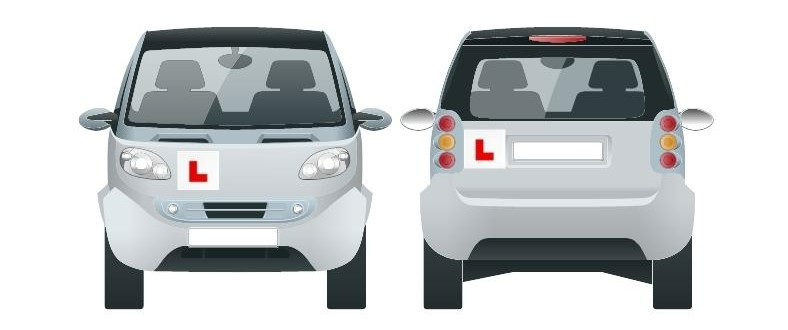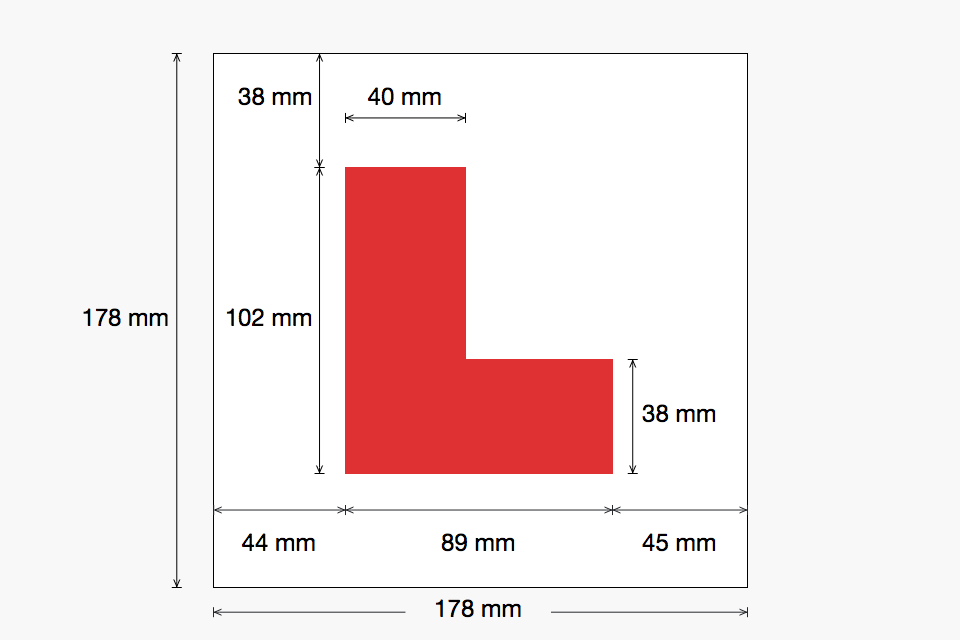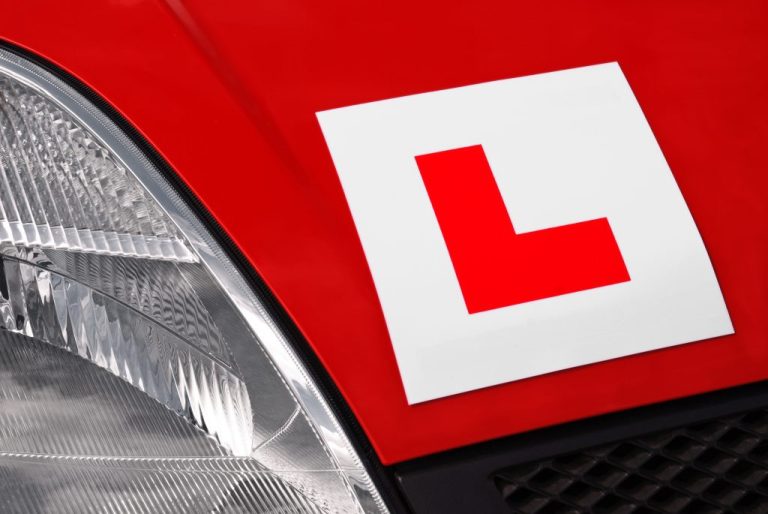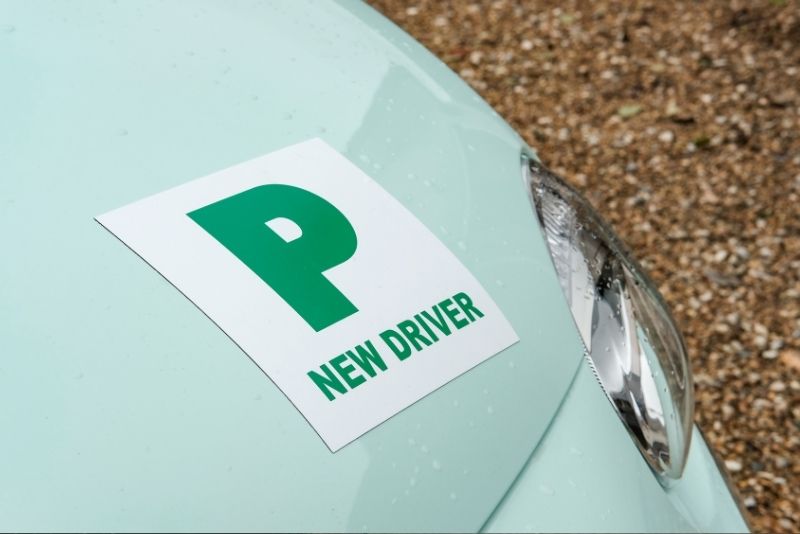Learner drivers need to understand the rules of the road when learning to drive. They also need to know all about Learner plates. In particular, the rules around using them, where and how to apply them and whether you need to display P plates once you have passed your driving test.
What are L plates?
‘L’ stands for ‘Learner’ and L plates are white and red square signs that are displayed on your car to show that you are a learner driver.
Learner drivers must display learner plates every time they drive a car. If a learner driver switches cars, they will need to move the L plates to the new car.
To ensure visibility to other road users, there are strict rules governing the size of the L and the plate itself which we will go into later.
What are D plates?
In Wales, you might see ‘D’ plates instead of L plates. The ‘D’ stands for ‘dysgwr’ which means ‘learner’ in Welsh. You can legally use either L plates or D plates if you’re learning in Wales.
D plates are only valid in Wales. If you’re planning to travel into England, you must switch to L plates.
Please get in touch with us about learner driver insurance
Do you need a licence to drive with L plates?
You must have a provisional licence to drive on UK roads using L plates. However, all Learner drivers must still be accompanied by a driving instructor or adult over the age of 21. This person will also need to be qualified to drive the vehicle and hold a full driving licence for three years or more.
Learner drivers are not permitted to drive on motorways unless with an approved driving instructor in a dual control car.
Does a Learner driver need L plates?
Displaying L plates is a condition of UK driving law. Any vehicle driven by a learner driver must always display red L plates. When learning to drive, you must display them on the front and rear of your vehicle, whether driving during the day or at night.
If the learner driver is not driving the vehicle, and someone else is driving it, you must remove the L plates. This is important to remember when learning to drive and practicing using the family car.
Can you use L plates if you are not a learner?
You are not permitted to use L plates if you are not a learner driver.
If you are driving with L plates on your car when you are not the learner, you must remove the L plates and replace them when the learner driver is driving the car.
The rule also applies to remove the L plates as soon as the learner driver passes their driving test. They will not need to await their full licence from the DVLA to remove the L plates.
Legally, L plates must be covered up by law if a learner is no longer driving the vehicle. The only exception is a driving instructor, and they must be driving their official driving school car.
How many L plates or P plates do you need on a car?
You will need to apply two L plates or P plates to your car, or vehicle to comply with UK law. You must make sure they are both the correct size and securely attached before you drive.
Where to put learner plates
If you are wondering whether you can put L-plates in your window or where they need to be positioned on the front and back of your car, we can clear that up for you too.
The rules simply state that you must display two L plates on your car:
- Both L plates must be visible from the front and back of the car.
- Never display L plates or P plates in the window of your car, as this can block your view of the road – a risk you don’t want to take when you are learning to drive.
- The best options for positioning are on the driving side front of bonnet, and the rear passenger side above the bumper.
Top Tip: Clean the area well using clean cloth. Removing the debris helps them stay put.

What happens if I don’t display L plates?
When learning to drive, you are legally required to display L plates on the front and rear of your vehicle when you are driving.
You must also ensure that they are exactly the right size. Please check the template at the end of this blog for guidance.
Failure to comply with the rules could land you with a fine and/or 6 points on your license. Although learner drivers can accumulate up to 11 penalty points on a provisional licence and still take a driving test, these points will be carried over to the full licence once you pass.
It is not ideal for new drivers to start driving with penalty points on their licence as this results in higher insurance premiums, or difficulties in finding an insurer willing to take the risk.
You also run a higher risk of losing your licence in the event of another error. The courts may elect to ban you from driving if you reach 12 points.
To get your driving years off to a great start, it is worth sticking to these few simple rules.
Car insurance for L plate drivers
Learner driver insurance is very different to regular driver insurance.
If you are a learner driver and using your family’s car to practice, it is important to put learner driver insurance in place that also protects your family’s No Claims Bonus.
You can opt for a short-term flexible learner driver insurance to cover you from 1 to 6 months. These specialist policies are designed to protect the car owners, with any claims make against the learner driver’s policy only and keep excess to a minimum.
It can be hard to know where to start when it comes to looking for learner driver insurance, so it is worth obtaining advice from a broker to make sure your family and the shared car are effectively covered.
What are P plates?
Pass plates? Not exactly. The ‘P’ stands for ‘probationary’.
P plates are not required by law. It’s entirely up to you whether you choose to display ‘P’ plates on your car after you’ve passed your test. Their purpose is to make other drivers aware of the fact that you’re recently passed your driving test and still building your confidence.
When other drivers see a P plate, they are more likely to be patient with you if you make a mistake. It is estimated that a young newly qualified driver is 30% more likely to have an accident than a driver with a year or more experience. Using an P plate can help build confidence and reduce stress when you are new to driving.
You are legally allowed to use P plates as long as you wish and a good solution for nervous or extra-cautious drivers.
Where do you display P plates?
You must display two P plates on your car and must be visible from the front and back of the car. Do not apply to windows as they will restrict your view making it unsafe for you to drive. The best options are on the driving side front of bonnet, and the rear passenger side above the bumper.
Top Tip: Take a look at this hack to help prevent your L plate from flying off.
Car insurance for P-Plate drivers.
You will not require learner driver insurance once you pass your test, however you will need new driver insurance.
If you are aged 17 – 27 you could opt to be insured on a parent’s car, while protecting their no claims discount, which is generally a more affordable option than being named on a new policy.
Some are pay-as you-go policies while some use black box technology, curfews and even an app to log the new driver’s journey. Black box technology rewards new, younger drivers for driving well, offering them discounts and scores as they go. The aim is to help a new young drivers build their own No Claims Discount without it impacting on their parent’s insurance.
New drivers over the age of 27 can also be insured using different policies. Once you have passed your driving test, speak to an insurance broker. They will be able to help you look at the latest products on the market to find the right one for you.
You will not be legally obliged to display a P plate to drive on a new driver policy.
Where to buy L plates or P plates
L plates are relatively inexpensive to buy and easy to purchase online, a garage forecourt, supermarket or somewhere like Halfords.
Packs of two L plates are available for under £5 on Amazon. Buying on sites like Amazon can be useful as you are able to read the reviews and make sure you are buying a set that sticks. You may need to consider buying more if they do fly off. You can also buy packs of L plates and P plates together for under £10.
Choose between the ones with magnetic strips, all over magnetic or self-adhesive stickers. Self-adhesive L plates are ideal for cars that have plastic bonnets, like Smart cars, but can leave glue marks on your car and will need extra cleaning after use.
For those in Wales, Welsh learner driver D plates are readily available on Amazon for around £6 for a pair.
Can you make learner plates?
L plates can be made at home but will need to comply with strict guidelines. Failure to get this right could see you landed with a fine or penalty points.
They will need to be 178mm x 178mm, the corners are permitted to be rounded. The red ‘L’ also needs to be a very specific size within the white square.
You will need to display one at the front and one at the back of your car where other road users can easily see them. Please do double check that home-made L plates are securely fastened as they will run the extra risk of being blown off.

Now that you know all about L plates, D plates and P plates, you will be in a good position to get out on the road safely and legally.
If you are learning to drive, or are about to take your test, get in touch with your local A-Plan branch. The friendly team will be happy to answer any questions you may have about the different types of insurances available for learners or new drivers.
Please get in touch with us about learner driver insurance
You could also read:
- Party season – check your limits now.
- Traffic light cameras: Everything you need to know
- Are you driving in an uninsured hotspot?
- Can I get insurance with a drink driving conviction?
- Your guide to insurance for 125cc motorcycles
- Free MOT status checker – Check a vehicle’s MOT history
- Try our free-to-use Car Tax Checker
- Private practice: everything you need to know
- Driving lesson anxiety: 10 tips for nervous drivers
- Are you ready for your test? Your driving test checklist
- What happens after I pass my driving test?


